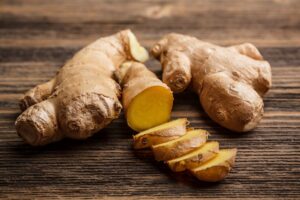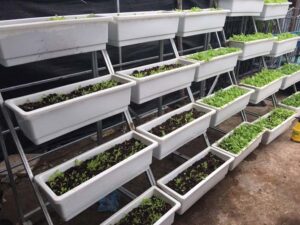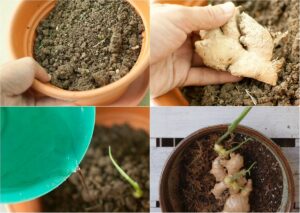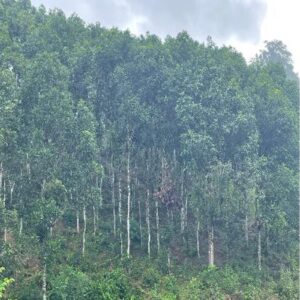Ginger and turmeric are the spices in most home and kitchen nowadays. So today DACE will share with everyone hơ to grow those spices at home – by yourself.
What is ginger?
Ginger is a perennial herb native to South East Asia, India, Ginger stem is about 1 meter high, ginger leaves are 30 to 50 cm long, alternatively growing in 2 rows along the stem. Under the right conditions, the young shoots will create and develop into new plants. The inside of the ginger root is light yellow and has many fibers. the fragrant ginger root is often used as a spice for dishes or for medicinal purpose.

What is turmeric?
Turmeric belongs to the herbaceous plant, about 60 – 100 centimeters high. The tree produces tall branches, cylindrical stems, roots are developed into bulbs fragant. The leaves turmeric grow alternately and are arranged in 2 symmetrical rows, the single leaf blades are usually 70 – 100 cm long and 38 – 40 cm wide, elliptical, tapered and narrow at the tip. The inflorescences are usually located between the leaves and have a sparse cone shape.

Planting tools
You can make use of available tools such as trays, pots, cement bags, styrofoam boxes or vacant land at home to grow ginger. Note, the planting tools must punch holes in the bottom so that the plants are not waterlogged and about 35-40cm high, 30-35cm wide.
Planting land
Ginger and turmeric are plants that prefer loose, humus-rich soil with a pH of 6-7.5. You can buy or mix the soil with rice husk, coir, cow dung, chicken manure, bird droppings, duck geese, fish manure, vermicompost…
About a week before planting turmeric and ginger, bring the soil to prepare. First pick up all the dirt and pull out all the weeds in the soil. Then dig up the soil and chop it into small pieces.
selection of ginger seeds and turmeric seeds
Because turmeric is a plant that reproduces asexually, it is not grown by roots, but by bulbs. When the tubers are pinned to the ground, pseudo-stems from the bulbs will grow, on these stems will continue to sprout flowers and leaves.
Turmeric and ginger are selected as seeds for planting, which requires going through two important stages of the growth period, which is growing large bulbs and falling flowers and leaves.
Technical guide to care for turmeric and ginger
1.1 Fertilizers
After sowing the tubers in the beds, farmers apply fertilizers to provide an abundant source of nutrients for the plants to grow.
1.2 Fertilizing the first time
After sowing turmeric and ginger in the ground for 7 days, you apply 200 gr / m2.
Second time: 20 days after planting turmeric andginger.
3rd time: 15 – 20 days apart from the second time, then every 15-20 days, fertilize the plants.
Note:
The above fertilizers are all organic, so you can be assured of your products.
Fertilizing combines weeding, plowing, clearing and plowing the soil for stronger plants!
Spray water for ginger and turmeric
If you grow turmeric or ginger in the hot dry season, you need to water twice a day for the plant to grow well.
To limit transpiration, cover the base of the plant with straw. When watering, always include straw so that they retain moisture and nourish the plant, helping the plant to grow normally.
However, attention must be paid to drainage when planting in beds and shielding plants when growing in pots to avoid water logging and root rot.
Preventing harmful pests
Pest control is an indispensable planting technique. Especially for root crops like turmeric.
Turmeric often encounters conditions such as tuber rot, leaf yellowing, leaf burning, etc. To prevent these conditions, people should fertilize and fertilize periodically to create an open space for the plants to breathe. At the same time, water appropriately according to the weather situation to avoid excess water causing the roots to be waterlogged or rotten.
In order not to consume nutrients for the cultivation of turmeric, please trim the leaves when planting!
Harvesting Turmeric & Ginger
Usually after 8-9 months of planting, people can already harvest turmeric and ginger.
When you see turmeric leaves turn yellow and wither.
for ginger, 2/3 of the leaves are withered, for turmeric try cutting a small turmeric branch. If the inside of the tuber is dark yellow or dark orange, people can proceed to harvest.
When harvesting, people choose a dry day, cut off all the stems and leaves of turmeric, then pull the whole bunch up to scrape off the soil around them.
Dace hopes this article on how to grow turmeric and ginger at home will be useful to you. Good luck.
————————————————— ———————-
Agricultural Development and Environmental Consulting Company Limited (DACE)
Phone : +84 97 24 99959
Email : contact@dace.vn





